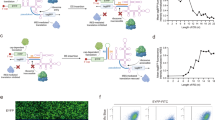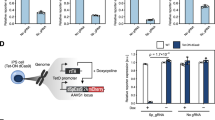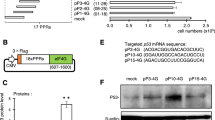Abstract
Programmable protein scaffolds that target DNA are invaluable tools for genome engineering and designer control of transcription. RNA manipulation provides broad new opportunities for control, including changes in translation. PUF proteins are an attractive platform for that purpose because they bind specific single-stranded RNA sequences by using short repeated modules, each contributing three amino acids that contact an RNA base. Here, we identified the specificities of natural and designed combinations of those three amino acids, using a large randomized RNA library. The resulting specificity code reveals the RNA binding preferences of natural proteins and enables the design of new specificities. Using the code and a translational activation domain, we designed a protein that targets endogenous cyclin B1 mRNA in human cells, increasing sensitivity to chemotherapeutic drugs. Our study provides a guide for rational design of engineered mRNA control, including translational stimulation.
This is a preview of subscription content, access via your institution
Access options
Subscribe to this journal
Receive 12 print issues and online access
$189.00 per year
only $15.75 per issue
Buy this article
- Purchase on Springer Link
- Instant access to full article PDF
Prices may be subject to local taxes which are calculated during checkout






Similar content being viewed by others
References
Proudfoot, C., McPherson, A.L., Kolb, A.F. & Stark, W.M. Zinc finger recombinases with adaptable DNA sequence specificity. PLoS ONE 6, e19537 (2011).
Wood, A.J. et al. Targeted genome editing across species using ZFNs and TALENs. Science 333, 307 (2011).
Wickens, M., Bernstein, D.S., Kimble, J. & Parker, R. A PUF family portrait: 3′UTR regulation as a way of life. Trends Genet. 18, 150–157 (2002).
Campbell, Z.T. et al. Cooperativity in RNA-protein interactions: global analysis of RNA binding specificity. Cell Reports 1, 570–581 (2012).
Galgano, A. et al. Comparative analysis of mRNA targets for human PUF-family proteins suggests extensive interaction with the miRNA regulatory system. PLoS ONE 3, e3164 (2008).
Gerber, A.P., Herschlag, D. & Brown, P.O. Extensive association of functionally and cytotopically related mRNAs with Puf family RNA-binding proteins in yeast. PLoS Biol. 2, E79 (2004).
Kershner, A.M. & Kimble, J. Genome-wide analysis of mRNA targets for Caenorhabditis elegans FBF, a conserved stem cell regulator. Proc. Natl. Acad. Sci. USA 107, 3936–3941 (2010).
Hafner, M. et al. Transcriptome-wide identification of RNA-binding protein and microRNA target sites by PAR-CLIP. Cell 141, 129–141 (2010).
Wang, Y., Opperman, L., Wickens, M. & Hall, T.M. Structural basis for specific recognition of multiple mRNA targets by a PUF regulatory protein. Proc. Natl. Acad. Sci. USA 106, 20186–20191 (2009).
Wang, X., McLachlan, J., Zamore, P.D. & Hall, T.M. Modular recognition of RNA by a human pumilio-homology domain. Cell 110, 501–512 (2002).
Wang, X., Zamore, P.D. & Hall, T.M. Crystal structure of a Pumilio homology domain. Mol. Cell 7, 855–865 (2001).
Zhu, D., Stumpf, C.R., Krahn, J.M., Wickens, M. & Hall, T.M. A 5′ cytosine binding pocket in Puf3p specifies regulation of mitochondrial mRNAs. Proc. Natl. Acad. Sci. USA 106, 20192–20197 (2009).
Koh, Y.Y. et al. Stacking interactions in PUF-RNA complexes. RNA 17, 718–727 (2011).
Wang, Y., Wang, Z. & Tanaka Hall, T.M. Engineered proteins with Pumilio/fem-3 mRNA binding factor scaffold to manipulate RNA metabolism. FEBS J. 280, 3755–3767 (2013).
Opperman, L., Hook, B., DeFino, M., Bernstein, D.S. & Wickens, M. A single spacer nucleotide determines the specificities of two mRNA regulatory proteins. Nat. Struct. Mol. Biol. 12, 945–951 (2005).
Dong, S. et al. Specific and modular binding code for cytosine recognition in Pumilio/FBF (PUF) RNA-binding domains. J. Biol. Chem. 286, 26732–26742 (2011).
Filipovska, A., Razif, M.F., Nygard, K.K. & Rackham, O. A universal code for RNA recognition by PUF proteins. Nat. Chem. Biol. 7, 425–427 (2011).
Bernstein, D., Hook, B., Hajarnavis, A., Opperman, L. & Wickens, M. Binding specificity and mRNA targets of a C. elegans PUF protein, FBF-1. RNA 11, 447–458 (2005).
Valley, C.T. et al. Patterns and plasticity in RNA-protein interactions enable recruitment of multiple proteins through a single site. Proc. Natl. Acad. Sci. USA 109, 6054–6059 (2012).
Qiu, C. et al. Divergence of Pumilio/fem-3 mRNA binding factor (PUF) protein specificity through variations in an RNA-binding pocket. J. Biol. Chem. 287, 6949–6957 (2012).
Stumpf, C.R., Kimble, J. & Wickens, M. A Caenorhabditis elegans PUF protein family with distinct RNA binding specificity. RNA 14, 1550–1557 (2008).
Tuerk, C. & Gold, L. Systematic evolution of ligands by exponential enrichment: RNA ligands to bacteriophage T4 DNA polymerase. Science 249, 505–510 (1990).
Ellington, A.D. & Szostak, J.W. In vitro selection of RNA molecules that bind specific ligands. Nature 346, 818–822 (1990).
Carlson, C.D. et al. Specificity landscapes of DNA binding molecules elucidate biological function. Proc. Natl. Acad. Sci. USA 107, 4544–4549 (2010).
Miller, M.T., Higgin, J.J. & Hall, T.M. Basis of altered RNA-binding specificity by PUF proteins revealed by crystal structures of yeast Puf4p. Nat. Struct. Mol. Biol. 15, 397–402 (2008).
Brito, D.A. & Rieder, C.L. The ability to survive mitosis in the presence of microtubule poisons differs significantly between human nontransformed (RPE-1) and cancer (U2OS, HeLa) cells. Cell Motil. Cytoskeleton 66, 437–447 (2009).
Russo, A.J. et al. E2F-1 overexpression in U2OS cells increases cyclin B1 levels and cdc2 kinase activity and sensitizes cells to antimitotic agents. Cancer Res. 66, 7253–7260 (2006).
Valencia-Sanchez, M.A., Liu, J., Hannon, G.J. & Parker, R. Control of translation and mRNA degradation by miRNAs and siRNAs. Genes Dev. 20, 515–524 (2006).
Gray, N.K., Collar, J.M., Dickson, K.S. & Wickens, M. Multiple portions of poly(A)-binding protein stimulate translation in vivo. EMBO J. 19, 4723–4733 (2000).
Lam, K.N., van Bakel, H., Cote, A.G., van der Ven, A. & Hughes, T.R. Sequence specificity is obtained from the majority of modular C2H2 zinc-finger arrays. Nucleic Acids Res. 39, 4680–4690 (2011).
Enuameh, M.S. et al. Global analysis of Drosophila Cys2-His2 zinc finger proteins reveals a multitude of novel recognition motifs and binding determinants. Genome Res. 23, 928–940 (2013).
Lu, G. & Hall, T.M. Alternate modes of cognate RNA recognition by human PUMILIO proteins. Structure 19, 361–367 (2011).
Campbell, Z.T. & Baldwin, T.O. Two lysine residues in the bacterial luciferase mobile loop stabilize reaction intermediates. J. Biol. Chem. 284, 32827–32834 (2009).
Campbell, Z.T. & Baldwin, T.O. Fre is the major flavin reductase supporting bioluminescence from Vibrio harveyi luciferase in Escherichia coli. J. Biol. Chem. 284, 8322–8328 (2009).
LeGendre, J.B. et al. RNA targets and specificity of Staufen, a double-stranded RNA-binding protein in Caenorhabditis elegans. J. Biol. Chem. 288, 2532–2545 (2013).
Li, L. et al. GLIPR1 suppresses prostate cancer development through targeted oncoprotein destruction. Cancer Res. 71, 7694–7704 (2011).
Gibson, D.G. et al. Enzymatic assembly of DNA molecules up to several hundred kilobases. Nat. Methods 6, 343–345 (2009).
Acknowledgements
We thank L. Vanderploeg for help with figures and M. Preston and S. Waghray for careful editing. This work was supported by US National Institutes of Health grant GM050942 to M.W. U2OS and HeLa cells were kind gifts from S. Miyamoto and R. Raines (both at University of Wisconsin–Madison), respectively.
Author information
Authors and Affiliations
Contributions
Z.T.C. and C.T.V. performed the experiments. Z.T.C., M.W. and C.T.V. wrote the manuscript.
Corresponding author
Ethics declarations
Competing interests
The authors declare no competing financial interests.
Integrated supplementary information
Supplementary Figure 1 Specificity coefficients and generality of the TRM code.
(A) The ranking of TRM specificity is shown based on the percent enrichment of the dominant base at position +2 multiplied by the inverse sum of non-WT identities at the +1 and +3 bases. The specificity coefficient thus includes both the preference for the new base at the targeted site as well as the “offtarget” effects at flanking positions. Higher specificity coefficients indicate greater selectivity for a switch in identity only at the “targeted” base (in this case, +2). (B) The mean specificities for G, U, and A were calculated and compared using a two-tailed Student's T-test (error bars represent s.d.). Exclusion of the wild-type TRM from the G-specific group does not eliminate the level of significance when comparing G and A TRMs. (C) The specificities of natural and designed TRMs were compared, as in Panel (A). Natural proteins are slightly more specific (average 0.37 versus designed average 0.24).
Supplementary Figure 2 Analysis of cytosine binding.
(A) Ranking of TRMs by percentage of binding elements with C at position 2. TRMs previously described as preferential C-binders are SR-Y, AR-Y, and CR-Y in the context of human PUM (Dong, S. et al. Specific and modular binding code for cytosine recognition in Pumilio/FBF (PUF) RNA-binding domains. J. Biol. Chem. 286, 26732-26742 (2011). and Filipovska, A., Razif, M.F., Nygard, K.K. & Rackham, O. A universal code for RNA recognition by PUF proteins. Nat. Chem. Biol. 7, 425-427 (2011)) (B) Correlation between specificity and C-binding preferences. The relative degree of non-specific binding was defined as the sum of all non-consensus bases for a TRM at position two and was plotted against the frequency of cytosine at position 2.
Supplementary Figure 3 Relationships between TRM composition and degeneracy at flanking sites.
Prevalence of mismatches at the flanking nucleotides +1 (A) and +3 (B). Prevalence of mismatches at the +1 (C) and +3 (D) positions and physiochemical properties of edge on-residues. Significance values were determined by two-tailed Student's t-test. Error bars, s.d. (n = 3 independent colonies).
Supplementary Figure 4 Effects of TRM substitutions on flanking bases.
(A) The binding arrangement of a canonical binding element is shown as a schematic. The four bases examined in the figure are shown in red ovals opposite the PUF repeats (boxes). Quantification across all enriched binding elements with single substitutions at the -1,+1,+2, and +3 bases are shown in panels B-E, respectively. G, A, U, and C are shown in yellow, green, red, and blue, respectively.
Supplementary Figure 5 Identification of Dictyostelium TRMs.
(A) The PUF proteins from Dictyostelium were aligned to PUM2 for identification of TRM combinations (red). (B) Predictions for RNA binding derived from TRM code reported in Fig. 2.
Supplementary Figure 6 Wild-type PUM2 binding to various sequence variants.
RNA mutants are shaded in brown according to the key. RNA sequences are provided for variant sites. Red nucleotides indicate sites that differ from the wild-type sequence. Binding activity measurements were conducted in the yeast-three hybrid system. Error bars are s.d. from three individual colonies.
Supplementary Figure 7 Properties of the Neo-PUF and Neo-activator.
(A) Expression of myc-tagged transfected proteins in U2OS cells probed by immunoblot analysis. Acronyms are as follows - Cyclin B1 refers to full length Cyclin B1, neo-PUF refers to FBF-2 bearing the repeat 3 NQ-H substitution, RNADEF is the neo-PUF containing an RNA binding defective allele of FBF-2 with the H326A substitution, PAB is PAB1p RRMs 1-3, RNADEF-PAB is the neo-PUF containing the H326A mutation fused to PAB, and neo-activator is FBF-2 bearing the repeat 3 NQ-H substitution characterized in the main text fused to PAB. (B) RT-PCR analysis of neo-PUF binding to either to the cyclin B1 transcript (CCNB1) or a negative control (CCNA2) in vivo. U2OS cells were transfected with equivalent amounts of the indicated vectors and transcripts were isolated by RNA immuno-precipitation and RT-PCR. (C) Growth rate (inferred from measurement of metabolic flux) for U2OS cells transformed with either Cyclin B1 or the neo-activator was increased relative to vector alone or an RNA binding defective PUF–PAB chimera. Significance values were determined by twotailed Student's t-test (* denotes P < 0.05, ** denotes P < 0.01). Error bars are s.d. from three cell cultures. (D) U2OS cells were treated with taxol for 12 hours to induce arrest. The drug was removed and the cells were allowed to recover in fresh media for four hours. The relative percentage of cells remaining in mitosis was determined by immunostaining for phosopho histone H3. Significance values were determined by two-tailed Student's t-test (* denotes P < 0.05, ** denotes P < 0.01). Error bars are s.d. from three cell cultures.
Supplementary Figure 8 Uncropped blot images.
(A-B) Related to Fig. 6
Supplementary information
Supplementary Text and Figures
Supplementary Figures 1–8 (PDF 1829 kb)
Rights and permissions
About this article
Cite this article
Campbell, Z., Valley, C. & Wickens, M. A protein-RNA specificity code enables targeted activation of an endogenous human transcript. Nat Struct Mol Biol 21, 732–738 (2014). https://doi.org/10.1038/nsmb.2847
Received:
Accepted:
Published:
Issue Date:
DOI: https://doi.org/10.1038/nsmb.2847
This article is cited by
-
Translational enhancement of target endogenous mRNA in mammalian cells using programmable RNA-binding pentatricopeptide repeat proteins
Scientific Reports (2024)
-
Two distinct binding modes provide the RNA-binding protein RbFox with extraordinary sequence specificity
Nature Communications (2023)
-
Pervasive translation of circular RNAs driven by short IRES-like elements
Nature Communications (2022)
-
Expanding the binding specificity for RNA recognition by a PUF domain
Nature Communications (2021)
-
Modulation of miRNA function by natural and synthetic RNA-binding proteins in cancer
Cellular and Molecular Life Sciences (2019)



